Knights and Tactics of the Hundred Years War: Battles at Sea
and in the middle and open at the stern. Single mast, it is by the nature of its rig
was a cross between a felucca and a lugger. Apparently
the skipper Arblester was doing excellently, as barrels of French wine
filled the entire hold. And in a small cabin, besides the image of the Virgin Mary,
who testified to the piety of the captain,
there were locked chests that spoke of his wealth and thrift».
"Black Arrow" by R. L. Stevenson
Military story countries and peoples. In the XNUMXth century, the sea also became the site of fierce battles, with the greatest military activity taking place in the English Channel, although many battles also took place in the turbulent Bay of Biscay. And the most interesting thing is that the ships of the beginning of the XIV century were not intended for combat, especially defensive. Warships, if they can be called such, were designed in such a way that they could be used to attack merchant ships, as well as transport troops for raids on enemy coastal lands. Privateering and piracy were very widespread, as well as attacks on single ships or on small groups of enemy ships at anchor.
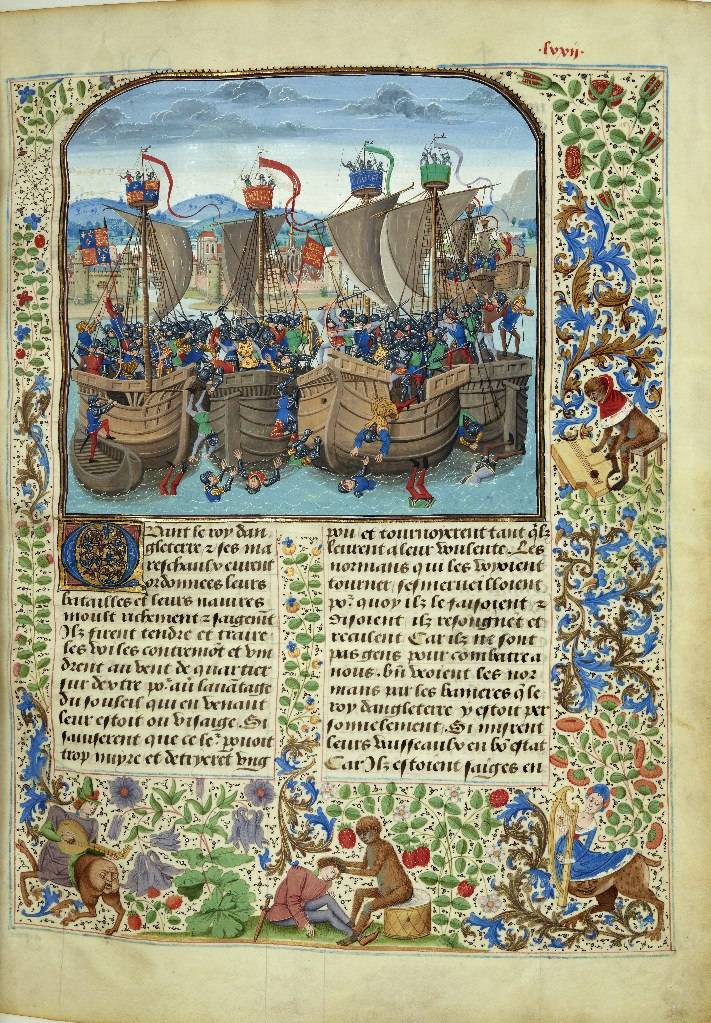
The typical ship of the northern seas at this time was the kogg - a high-sided, short but wide ship, with superstructures at the stern and bow. These superstructures also had wooden sides made of thick planks, often with battlements similar to the battlements of the towers and walls of medieval fortresses, behind which it was convenient for shooters - crossbowmen and archers, to hide, and for this reason they were called "castles" ("castles"). Thus, the warriors on the cog could, with sufficient convenience, operate at once both from the stern and from the bow of this floating wooden fortress. Another "firing point" was on the mast, where 3-4 archers could be in the "crow's nest". The large rectangular sail did not allow steep maneuvers to the wind, but these ships already had a real rudder, while steering oars were still used on the Mediterranean ships.
Both the French and their Spanish allies also sailed on galleys - more powerful sailing and rowing warships, which, however, were not adapted for sailing in the harsh northern seas. In the famous Clos de Gale in Rouen, they were also engaged in the construction of many types of ships, such as battels, battelins, barges, coca and coggs.
Naturally, all members of the ship's crew of that time were armed in one way or another. For example, the armor and weapons of the crew of a small galliot in 1330 could consist of chain mail, gambesons, shields of various shapes, bascinet helmets, and of course, he had crossbows with arrows, bows and spears. The crews of the larger nave ships were similarly armed. On the galleys, the soldiers had both heavy bascinet helmets and chapel helmets. Putting on all this was required quickly, as well as taking off, because, being in the water, being dressed in armor, the warrior did not have the slightest chance to escape and went like a stone to the bottom.
Battle of Sluis
The most famous, perhaps, in the history of naval battles of the Hundred Years War was the naval battle of Sleis, which took place on June 22, 1340.
King Edward III of England had previously assembled the maximum possible number of ships to attack the enemy. In the Chronicles of Jean Froissard it is indicated that he had 120 ships, naves and balangiers, on board of which there were 4 men at arms and 000 more archers.
Here it must be borne in mind that in the first half of the XIV century England was not a naval power, and its fleet was much inferior to the Spanish, French, and also Flemish.
Actually, this is a bunch of requisitioned coasters and fleet-that was not, moreover, it also consisted of small single-masted fishing and merchant ships. They were converted into warships very simply: they were brightly painted, and castles and battle marches on masts were arranged on the bow and stern.
The largest ships of Edward were the flagship nave "Thomas" and "Michael", but even their displacement did not exceed 250 tons. However, there is evidence that in quantitative terms the English fleet was superior to the French and that there were about 250 ships in it, although most of them were smaller in size than the French.
The British fleet approached Sluis Bay on 23 June. There was a combined fleet of the French, Spaniards, Genoese and Flemings of 200 ships, the largest of which was the nave "Christofle", by the way, previously captured from the British. Other ships were smaller, but nevertheless had on board 150-200 people in full armor. There were also very small ships. For example, the nave of the Assumption of Our Lady had only 80 sailors and soldiers on board.
In addition to ships of the cogg type, the Allies had about four dozen Genoese galleys, which made up the second line. As for the number, Froissart put it, including the Normans, Picardians and Genoese, at 40, but this is most likely an exaggeration.
At the head of the English fleet was King Edward III himself, as well as two admirals Robert Morley and Richard Fitzalan. The French fleet, which consisted of three squadrons, was led by Admiral Hugo Chirier, as well as Admirals Nicolas Beguchet and the Genoese Barbavera.
The French fleet, anchored, was lined up in four lines and, of course, in the very first there were both the largest and largest ships on which the Genoese crossbowmen were located. The British built a fleet in three lines, with the largest ships in the center. The flagship of Edward III's nave "Thomas" was also located here.
The battle began on June 24th.
Hugo Kirje, in the best traditions of the war of that time, decided to block the way to the Zvin Bay, where the docks of the port of Bruges exited, in chains, stretching them from one coast to the other through ships. It turned out to be a real "wooden wall", but the British, nevertheless, were not afraid of this, attacked the French head-on and began to clash with them on board. Despite desperate resistance, they managed to capture the flagship "Christofl", after which they simply threw overboard his entire Genoese team, and they themselves stationed their archers on it.
The battle, which lasted all day, ultimately ended in the complete defeat of the French. Played a role the maneuverability of British ships, not chained, which allowed 2-3 ships to lean on one "Frenchman". A significant role was also played by the significantly higher rate of fire of English archers, compared to arrows armed with crossbows, as well as slingers with slings. Various data are given on the losses of the French, but in general they are estimated at 16-000 people.
The rules of the knightly war were not observed at all.
Admiral Kirje was beheaded, Beguche was taken prisoner and ... hung, like a robber, on the mast, and Barbavere was killed, and the corpse was thrown from the ship into the sea.
- the British joked after this battle! Although the victory did not come cheap to them either. Even King Edward III himself was seriously wounded.
It is clear that after such a defeat, the French could no longer land their troops in England, but they did not lose the opportunity to build ships and replenish their fleet with them. In addition, many ships were hired for a fee along with the crew. For example, a record from the arsenal of Claude Gale shows that in 1346-1347 a Genoese galley called "Santa Maria" was hired, which had a crew of 210 people, including the captain ("master") Chrétien de Grimaud, three officers - the comité , su-komita (souz comité) and the priest; and all the other members of her crew, sailors and crossbowmen. And ten years later, another fleet was prepared in Rouen, which consisted of ten galleys, five large barges and three small bargots, which was supposed to deliver food to the coastal fortresses.
Nevertheless, even such a routine service could lead to naval combat clashes. Although the meeting of enemy ships at sea at that time almost always happened by chance. The battle began with a crossbow shootout, after which the ships went on boarding. Usually, crossbowmen and archers took up positions on high casts, fore and aft, since it was convenient to fire at the enemy from there. Here the advantage was given to those whose castles were higher, and their wooden sides were thicker.
In addition, from high castles it was easier to resist the enemy who seized the ship's deck, because they had to climb up high ladders. Because of the poor communication between several ships, it was difficult to control them, and the whole fleet had nothing to think about carrying out complex maneuvers. By 1377, it was considered necessary to have on board any large ship at least two large guns, which were supposed to fire lead balls instead of stone. At the same time, the guns were usually breech-loading and had several already loaded interchangeable chambers in stock at once, which made it possible to maintain a sufficiently high rate of fire and did not require pushing the guns out of the ports for loading. But stone-throwing machines, due to the tightness of the casts, were almost never installed on them.
The usual tactics of the British were large-scale raids on French territory, to which the French, for their part, responded with raids from the sea on individual coastal cities. At the same time, the French, as a rule, did not go deep into the territory.
So, in 1338, successful raids were made against the city of Portsmouth and the Isle of Wight, in 1360 - an attack on Winchelsea, then again on Portsmouth in 1369, on several ports between Portsmouth and Ray - in 1377, as well as on Gravesend in 1380. In addition, French and Scottish ships operated against the British in the North Sea and along the entire western coast of Britain.
In general, because of the winds prevailing in the English Channel and the harbors located in the strait, the French could not seriously threaten the British communications. The defeat at Sluis also played a role in this, and especially the capture of Calais by the British in 1347.
But France still continued to be a major maritime power and even sent sea expeditions. For example, such an expedition was the voyage of Jean IV de Bettencourt with the aim of conquering the Canary Islands in 1402.
PS
Продолжение следует ...
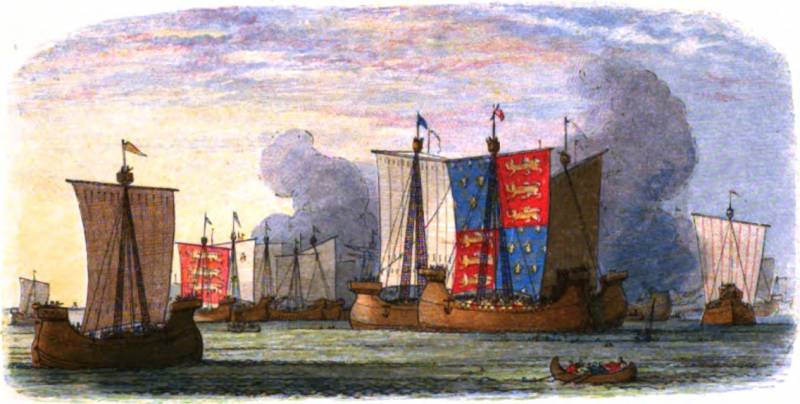
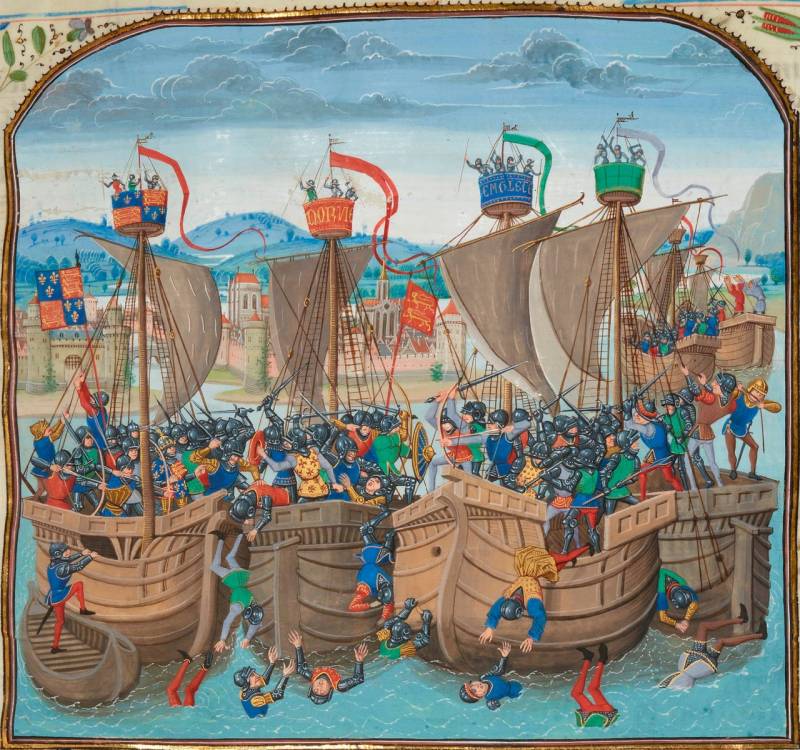
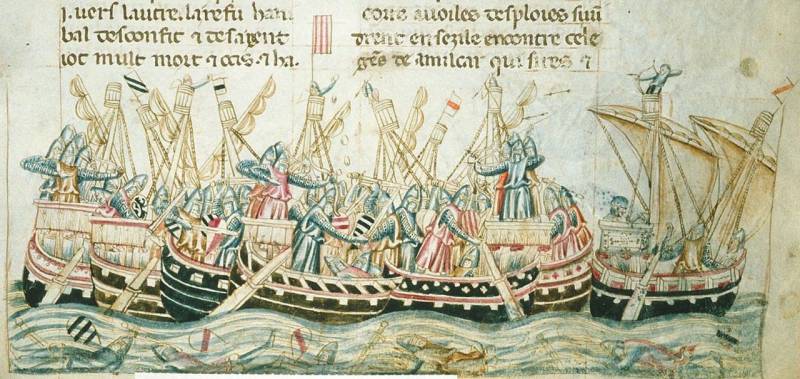
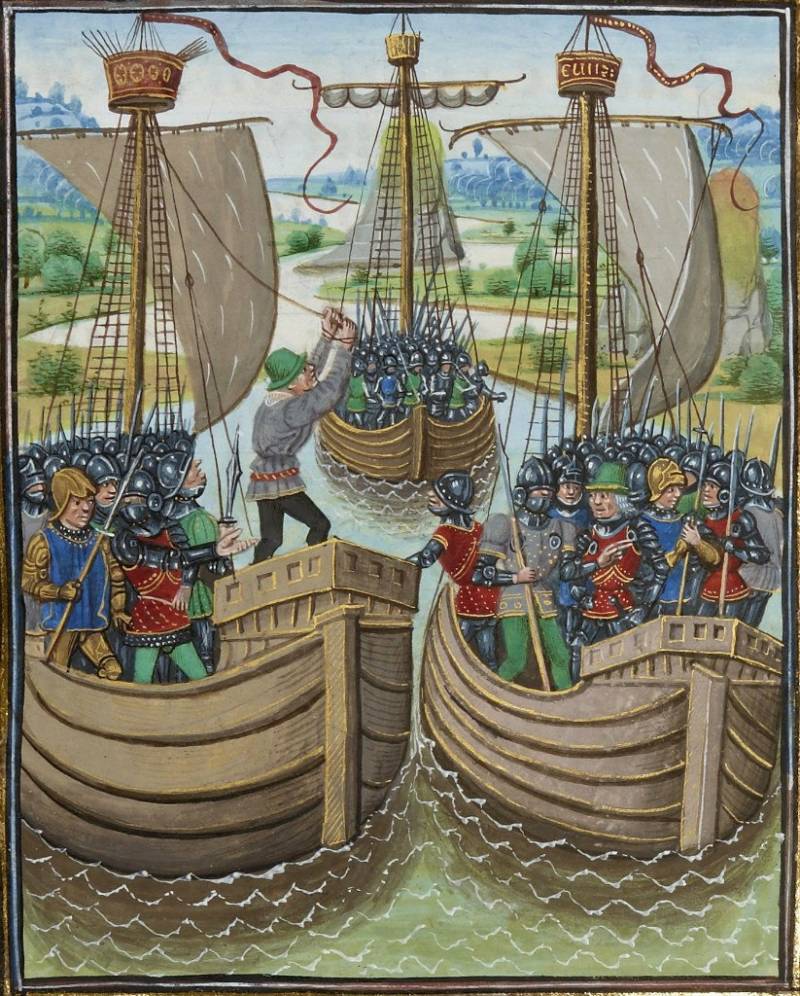
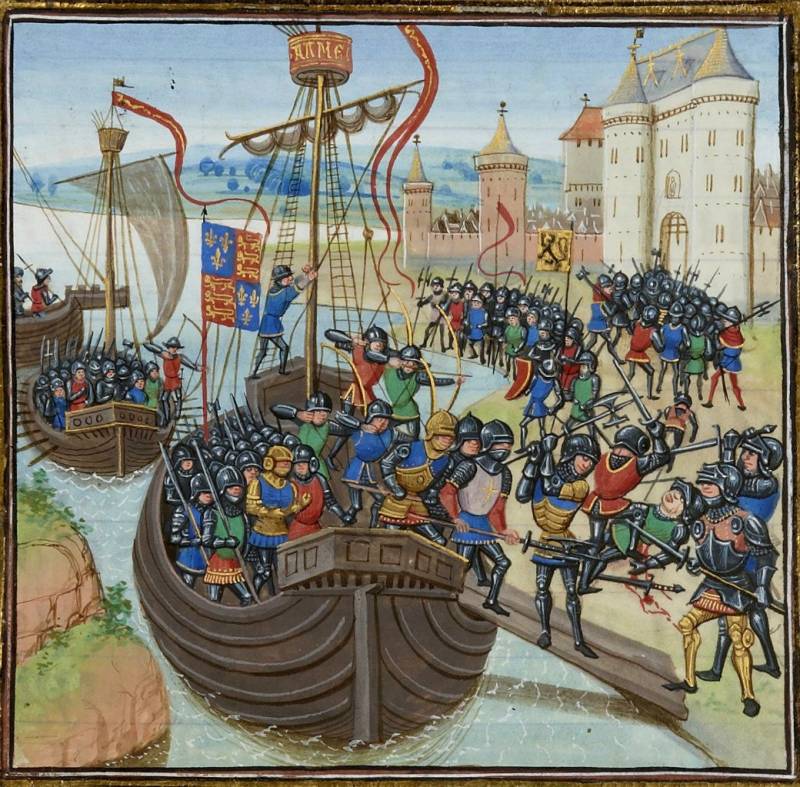
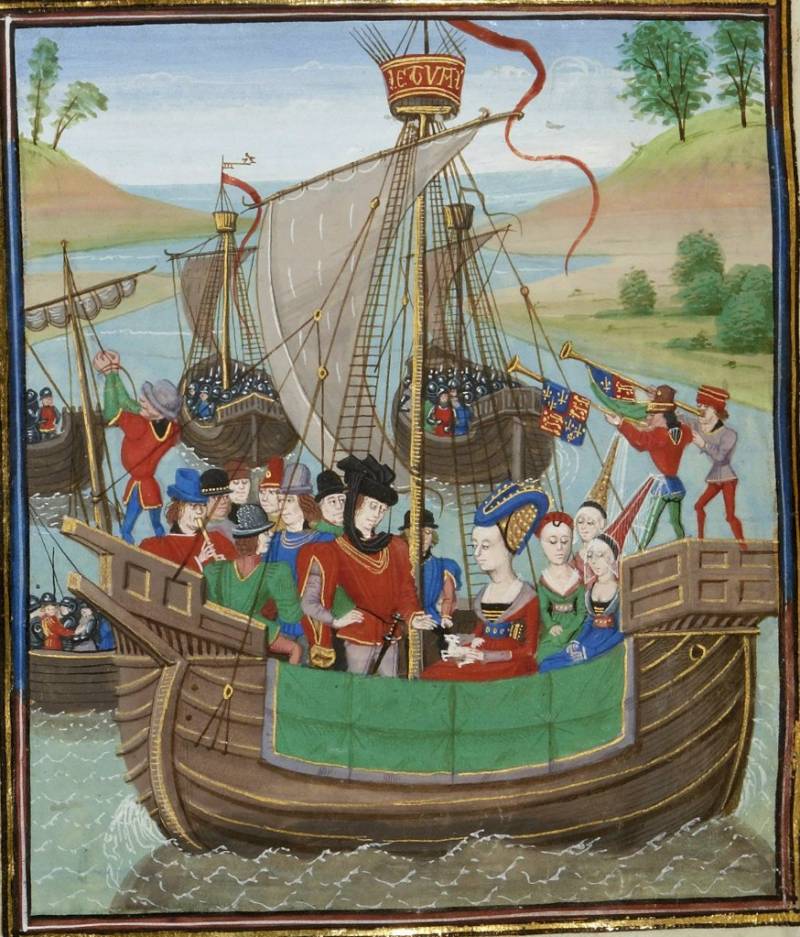
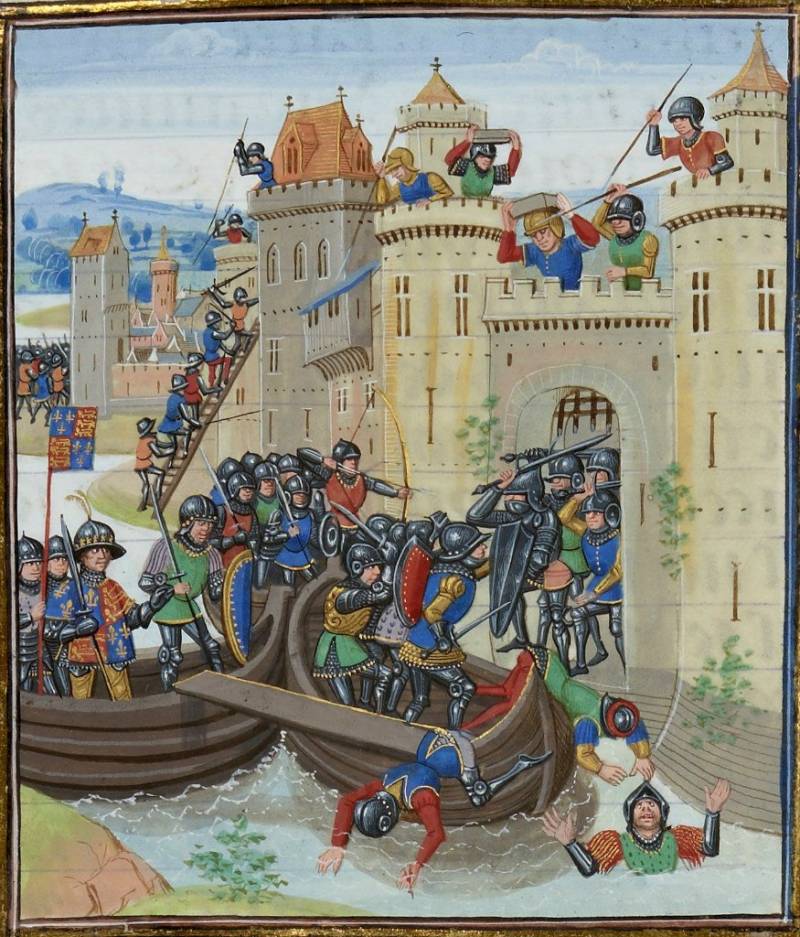
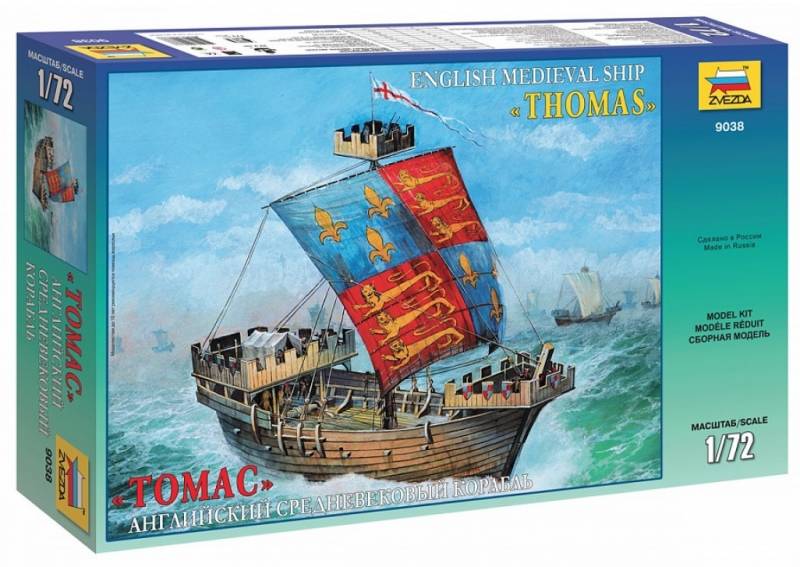
Information